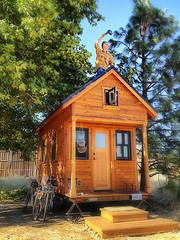Tiny Home Repair
 The tiny home movement of the last decade and a half is going strong. It holds a particular appeal for folks who want to reduce their environmental footprint, are interested in saving money, and have a generous dose of the pioneering spirit. There’s been a lot written recently on how to design, furnish, and live your daily life in a small-to-tiny abode. Most reports from tiny home dwellers are extremely positive, mentioning convenience and a feeling of freedom from physical and emotional clutter. But what happens when something goes wrong? How do you repair (or get someone else to repair) your tiny house?
The tiny home movement of the last decade and a half is going strong. It holds a particular appeal for folks who want to reduce their environmental footprint, are interested in saving money, and have a generous dose of the pioneering spirit. There’s been a lot written recently on how to design, furnish, and live your daily life in a small-to-tiny abode. Most reports from tiny home dwellers are extremely positive, mentioning convenience and a feeling of freedom from physical and emotional clutter. But what happens when something goes wrong? How do you repair (or get someone else to repair) your tiny house?
What is a Small or Tiny House?
Although there is no precise definition of the terms, “small” homes are generally considered to be houses less than 500 square feet (some stretch the parameter to a luxurious 600 square feet). “Tiny” homes are even more compact, usually measuring under 200 square feet in area. To compare, the former is about the size of the average family room in a newly built house, while the latter is equivalent to the typical master bathroom! Tiny homes are often constructed on the lot of an existing house, and the available living space may be extended by adding a sleeping loft. Frequently they are built as a DIY project by an idealistic owner, sometimes including repurposed materials.
Be Prepared
Before you even get started on building – or buying – a tiny house of your own, check out the red tape to avoid future hassles. Erecting any new home, no matter how tiny, will require a building permit as well as zoning permission, and must meet the standards of your local construction code. If your house is to be put up on its own plot of land and not adjacent to another home, connection to the regional water supply may be a complicated story. Make sure that you will be able to get homeowner’s insurance, plus additional coverage if your tiny home is mounted on wheels. It’s helpful to find out what the experience of other tiny homeowners has been. The upside of DIY construction is that the majority of those who build their tiny homes invest a great deal of research, self-education, and TLC in the project.
Repairing a Tiny Home
When it comes to repairing your tiny home, once again there are positive and negative factors. Many tiny homes are built in rural areas, such as the Colorado plains. If you are unable to find a repairperson locally with experience in dealing with tiny homes, you may have to go farther afield and hire a qualified Denver handyman to make a service call. Staying in your home while the repair work is in progress, particularly if it involves bulky equipment (a ladder, for example), may be impossible – which is fine in the summer when you can simply sit outside, but not so convenient in the winter months. Repairs to be made in the loft area might require special skills to work in such a cramped space.
However, on a more cheerful note, if you constructed the home yourself, you most likely picked up skills along the way which can be put to good use once again in repairing your tiny dwelling. And even for a major project such as replacing the roof, materials will be much less expensive, due to the smaller expanse that needs to be covered.
Laura Firszt writes for networx.com.
Looking for a Pro? Call us (866) 441-6648

Roofing Average Costs
Roofers Experiences

Rotted Fence Repair Taken Care Of Fast And Efficiently

Painting And Handyman Work On The Outside Of My House



